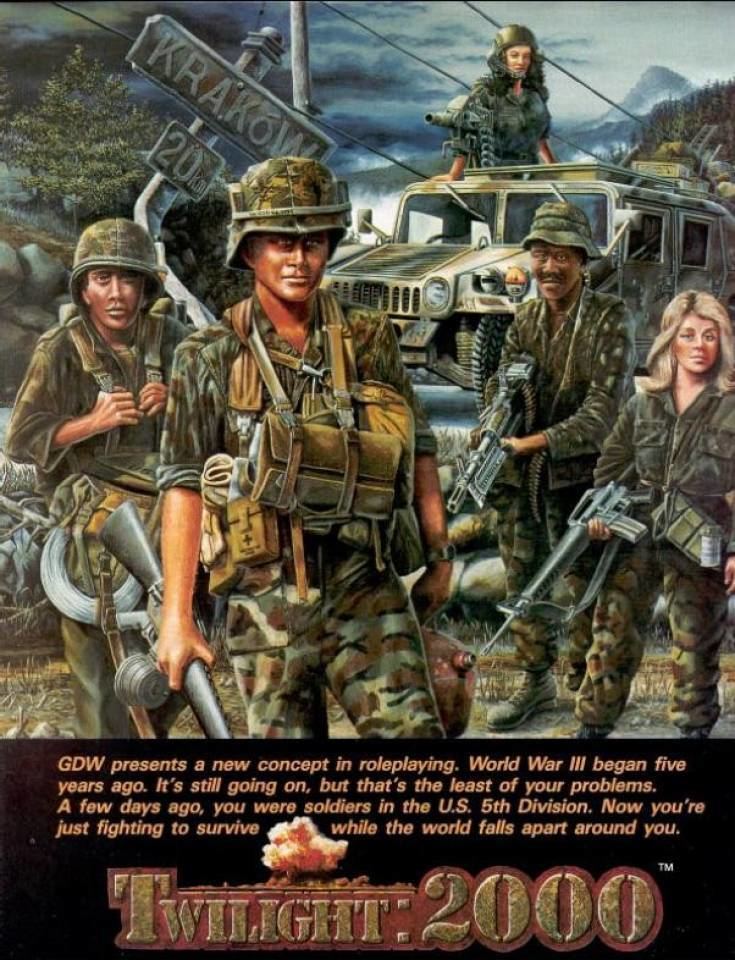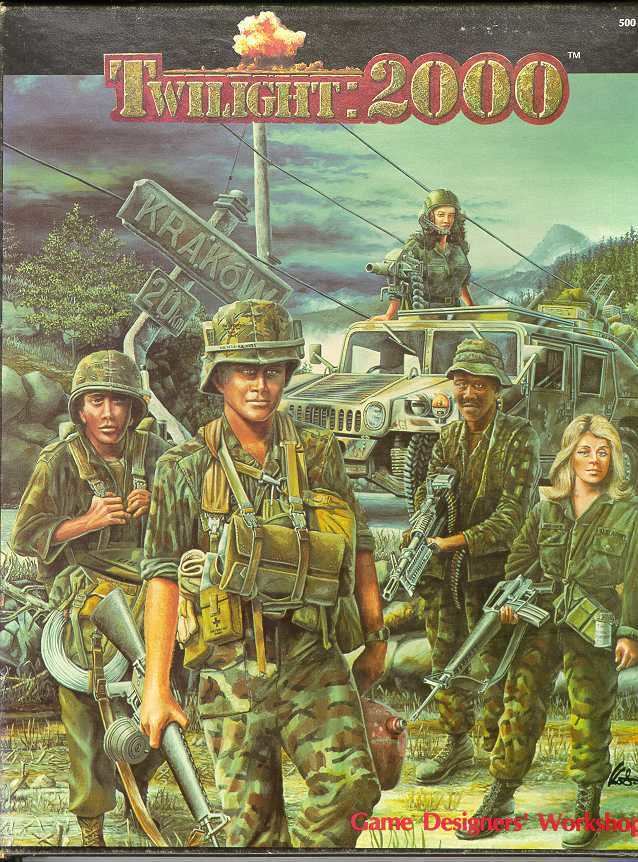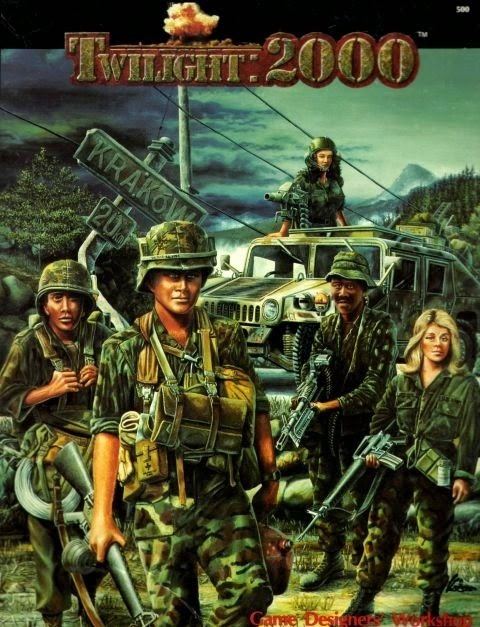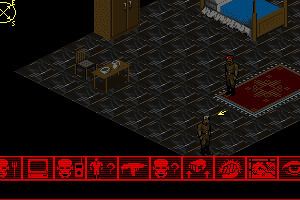Genre(s) Alternate history | System(s) Custom | |
Designer(s) Frank Chadwick, Dave Nilsen, Loren K. Wiseman, Lester W. Smith Publisher(s) Game Designers' Workshop Publication date 1984 (1.0)
1990 (2.0)
1993 (2.2)
2008 (Twilight: 2013) | ||
Twilight 2000 gameplay pc game 1991
Twilight 2000 is a role-playing game set in the aftermath of World War III (the "Twilight War"). The premise is that the United States/NATO and the Soviet Union/Warsaw Pact have fought a lengthy conventional war, followed by a (limited) nuclear war with all its consequences. Characters in the game are survivors of the war.
Contents
- Twilight 2000 gameplay pc game 1991
- History
- Original setting
- Later History
- Revised setting
- Merc 2000
- Cadillacs and Dinosaurs
- OPFOR Games
- Twilight 2013
- References

History

The adventures in Twilight 2000 typically involve a military unit which was stranded in Central Europe after the nuclear war and places emphasis on attempting to realistically depict military and social systems after a nuclear war.

The manufacturer of the game, Game Designers' Workshop (GDW), which is now owned by Tantalus, extended the timeline of Twilight 2000 to create the background history for the science fiction game 2300 AD; by doing so the rather depressing post-nuclear environment of Twilight 2000 is mitigated by the outcome in which the Earth rebuilds itself and begins to colonize space.

Far Future Enterprises has reprinted the first edition of Twilight 2000 in hardcopy (paper) format, and both the first edition and version 2.2 are available in CD-ROM format. Versions 2.0 and 2.2, both using the system that became standard for GDW's games, are currently available in watermarked PDF format from DriveThruRPG.com (as are the first edition rules).

Twilight 2000's success as a game can be attributed in part to its manner of presenting a military background and setting, without hemming the players into a military's command structure. The civilian governments of most countries in the game have been shattered (France and Belgium quit NATO and thus largely escaped war damage,) with the US government splitting into the civilian and military governments, as has the military chain of command, supply lines, etc. The various military forces are presented as being much weaker than their stated sizes, occupying civilian territories and relying on civilians for food and small-scale manufacturing, and recruiting from civilian populations to some extent. This all means that the players can feel they are part of a military of some sort, without their characters being forced to submit to higher military authority. Players generally can choose whether they want their characters to try to continue the war, get back home (wherever that may be), join one of the new power groups wherever they are, simply survive as mercenaries or marauders, or some combination.

In 1990, realizing that the game's background was in danger of becoming obsolete, GDW published Merc 2000, an alternative campaign setting which revolved around mercenaries fighting brushfire wars in a time in which the Twilight War never occurred. After Merc 2000 was released, many supplements and articles printed in GDW's Challenge Magazine featured Twilight 2000 with equipment and background conversions to Merc 2000 or were Merc 2000-only.

In 1991, GDW licensees Paragon developed the Twilight 2000 computer game adaptation (complete with expansion, "the Colonel") depicting a squad of 20 soldiers stranded behind enemy lines in Poland, struggling against the despot Baron Czarny.
Original setting
The game was first published in 1984 during the Cold War and was intended to be an accurate depiction of a possible future, but events in the world have rendered the premise of the game an alternate history.
In 1995, a series of Sino-Soviet border conflicts expanded into general war between the Soviet Union and China. The Sino-Soviet war rapidly escalated from conventional warfare into exchanges of nuclear, chemical, and biological weapons. In 1996 a cabal of East German and West German military officers seek to reunify their country. Unified German forces stage a coup d'état against the Group of Soviet Forces in Germany. The US and NATO allies initially attempt to stay out of the war, but are quickly drawn into the European conflict. France withdraws its military from Germany and withdraws entirely from NATO, declaring its neutrality in the conflict.
Between 1996 and 1997, a largely conventional war is fought between NATO and Warsaw Pact forces throughout Europe. There are limited exchanges of battlefield nuclear weapons, and chemical and biological weapons. During Thanksgiving 1997, the Soviet Union launches a surprise first strike against targets in the United States and Europe. The US and Great Britain launch retaliatory nuclear strikes against the Soviet Union. France, because of its neutrality, largely escapes direct damage.
In the aftermath of the nuclear exchanges, both blocs struggle to recover from the damage. The war continues - despite increasing shortages of men, equipment, and fuel. In the United States, there is a breach between the civilian government and the Joint Chiefs of Staff. An open rift develops between "Civgov" (the civilian government) and "Milgov" (the military government), which leads to a low-intensity civil war.
By the summer of 2000, the European theater of operations had been fought to a near stalemate. In one final effort to break the deadlock and end the war, NATO forces planned a summer offensive across Northern Poland and into the Baltics, but the offensive ground to a halt in the face of a Warsaw Pact counterattack. Several divisions and corps on each side were virtually eliminated. In the chaotic aftermath, supply lines are lost, high level command breaks down and armies in the European theater lose cohesion beyond the platoon unit. Some go “native’ and integrated with the militias of independent “free cities", others turned into gangs of marauding bandits and some small groups of surviving soldiers sought to find their way home.
Later History
To create 300 years of background history for their science-fiction RPG 2300AD, GDW staff members participated in an in-house simulation called "The Great Game", with Frank Chadwick as referee. Starting with the world situation in 2000 following the Twilight War, players controlled one or more countries and guided them through 300 years of development, including the discovery of faster-than-light space travel, colonization of other Earthlike planets, and contact with a variety of sentient aliens. The staff member playing France, John Harshman, did exceptionally well, leading to France being the supreme superpower in 2300.
Revised setting
The Second Edition (published in 1990) and subsequent editions featured a reworked background intended to be an alternate history closer to 1990s real-world history. Version 2.2, GDW's final edition of the game, was published in 1993 and featured a background in which the KGB's Alpha Group obeyed the coup leaders in the August 1991 Soviet coup attempt and stormed the Russian White House, killing Boris Yeltsin and effectively preserving communist control. This also had the effect of basically future-proofing the game, as anything that happened in Real Life after that period could be ignored as the event basically wiped out history after that.
Merc 2000
Merc 2000 is an alternative setting for the Twilight 2000 role-playing game by Game Designers' Workshop. Whereas Twilight 2000 was set in the immediate post-World War III era, with characters representing soldiers trying to survive, characters in Merc 2000 are mercenaries working for or against government forces in a world where the "Twilight War" involving nuclear weapons did not occur.
Merc 2000 must be used with Twilight 2000 versions 2.0 through 2.2; the earlier first-edition Twilight 2000 rules differ too much to be easily usable without extensive adaptation. The Merc 2000 rulebook details the game world, gives additional rules and equipment that will be more useful in mercenary campaigns than Twilight 2000 ones. It also supplies some basic adventures to play. Game Designers' Workshop also published a number of separate adventures for use with Merc 2000.
In GDW's own gaming magazine Challenge, they close the gaps between the setting of Merc 2000 and their future role-playing game Dark Conspiracy. Merc 2000-characters are confronted there with aliens as the world turns into the near-future setting of Dark Conspiracy.
Cadillacs and Dinosaurs
Cadillacs and Dinosaurs used the Twilight 2000 rules and was set in Mark Schultz's underground comic book series Xenozoic Tales. (ISBN 1-55878-073-4)
OPFOR Games
Characters in Twilight 2000 games are typically representative of US and NATO military forces. Within the T2K gaming community, games that are centered on a group of Soviet/Warsaw Pact characters are referred to as "OPFOR games" for opposing force. There are no full OPFOR games as published adventures, but the concept is a popular PBEM scenario.
Twilight: 2013
In 2006, 93 Games Studio announced that they had acquired the license to produce the official Twilight 2000 Version 3.0, and planned for a 2008 release with the title Twilight: 2013. According to the developers, the timeline leading to the Twilight War was completely re-written, and no longer focused on a Cold War confrontation between NATO, the Soviet Union and China.
The Twilight: 2013 core rules were released on 8 November 2008 as a PDF. The hard-copy edition is now in print.
In December 2010, 93 Games Studio announced it was going out of business. The future of the Twilight 2000 brand is unclear.
